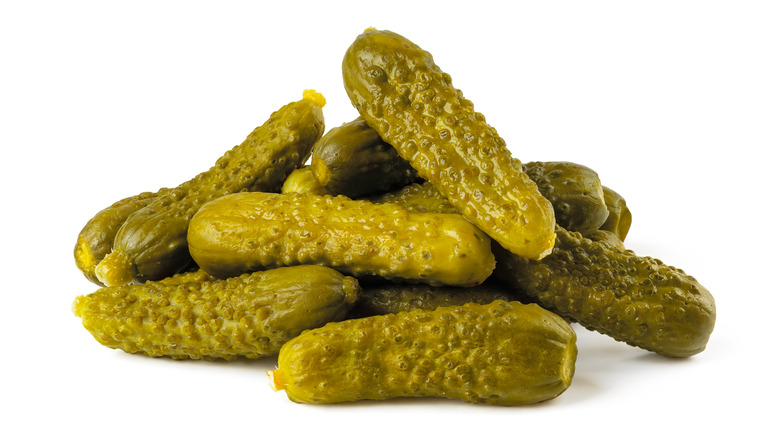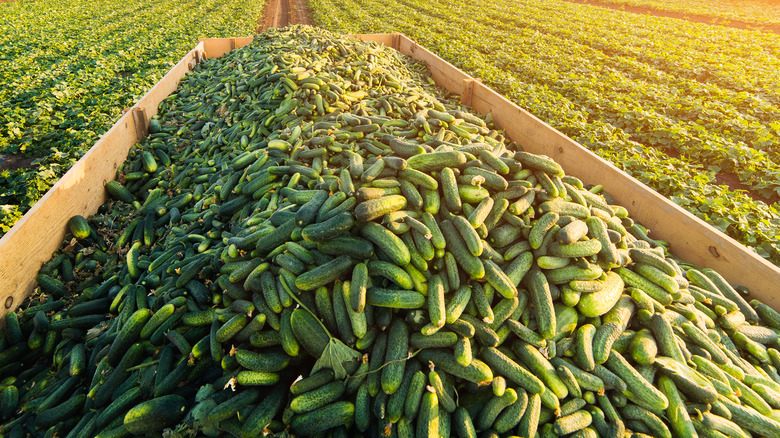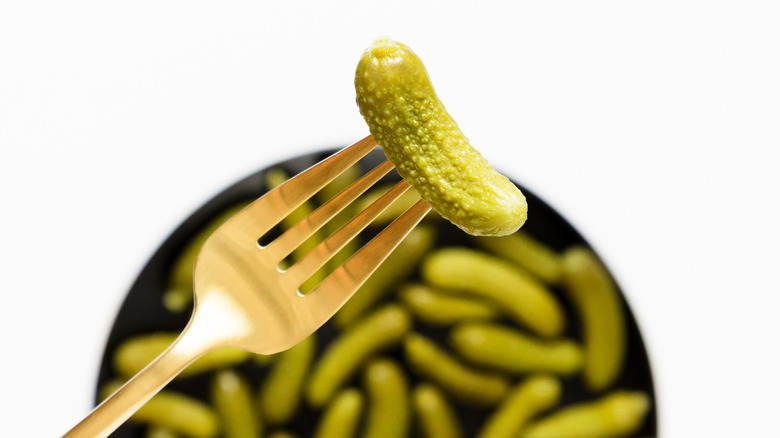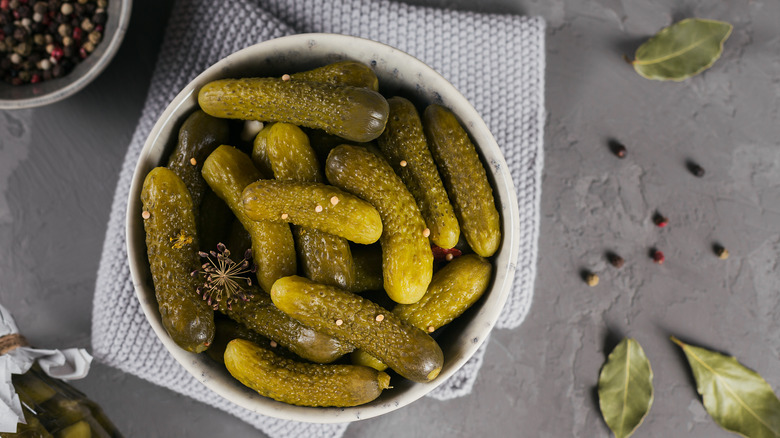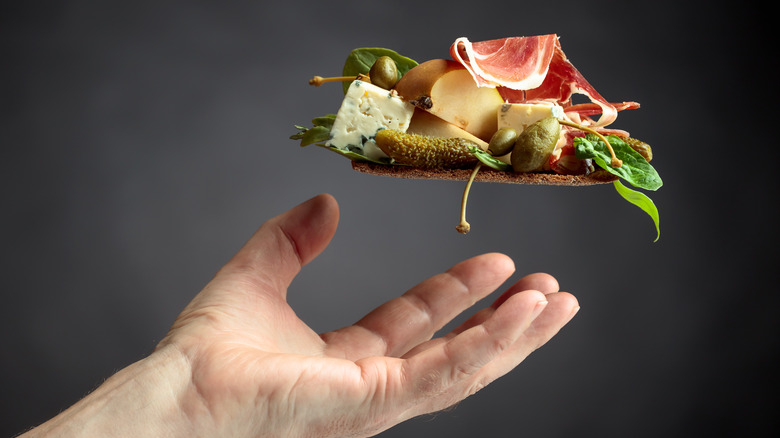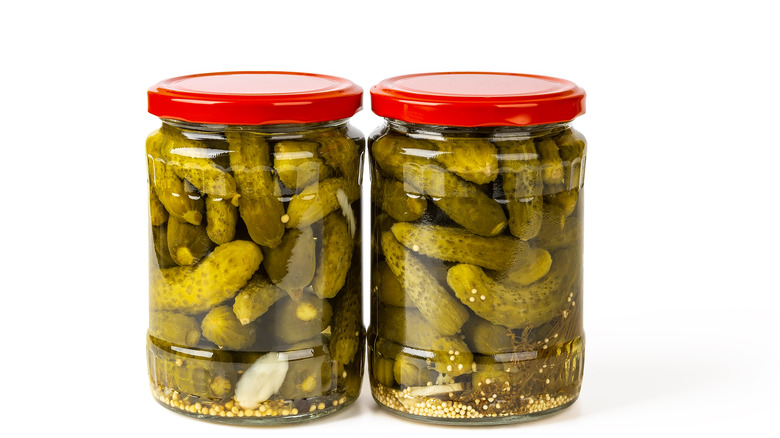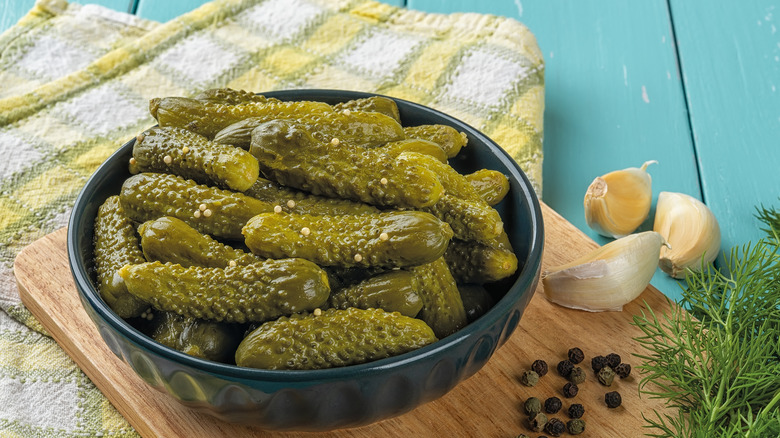What Are Cornichons And What Do They Taste Like?
Have you ever sampled the offerings of a charcuterie platter that literally only has meat and cheese on it? By the end of it, you might have been begging for something to break up the rich flavors you took off the plate, which is where the cornichon (pronounced "KOR-nee-shon") comes in. This baby-sized pickle stands out because it offers up a great contrast of flavors and can go well with a variety of dishes.
While the cornichon or "little horn" is as French an ingredient as it can get today, this type of gourd isn't native to the European continent. It was first discovered in India before it made its way westward to Europe and Africa. It wasn't until the 18th century that cornichons actually found their way into French cooking. Following on from there, cornichons were brought to the United States in the 19th century where they subsequently became "pickles" (via Specialty Produce).
What are cornichons?
Part of understanding what makes a cornichon a cornichon (as opposed to a typical pickle) is knowing what it is not. Cornichons are made with small-growing gherkins that, despite a striking resemblance, aren't technically cucumbers but are referred to as such (via The Kitchn). Approximately pinky-sized, the bumpy fruits measure less than 2 inches in length. Meanwhile, according to the American Farm Bureau, the pickles that many Americans are used to are often made with Persian or Kirby cucumbers. Due to their thick skin, Kirbys can sit in liquid for a while without giving up any of their crunch (via Bon Appétit).
Cornichons are made with one of three different varietals of gherkins: the Parisienne Cornichon de Bourbonne, Parigno Cornichon, and the Fin de Meaux. Historically, the Cornichon de Bourbonne was seen as the preferred gherkin for making this tart treat (via Kitchen Garden Seeds). No matter what you use, gherkins need to be harvested while they are still younglings since the little bumps just become spiky protrusions as the gourds age.
French cornichons aren't really French
While the cornichon's French roots run deep, it might surprise just about everyone to know that most of the tiny pickles consumed in France aren't actually grown there – they are grown in India and Eastern Europe. But it isn't because the will to cultivate wasn't there. AFP points out that the cucumber plant used to make cornichons is not only susceptible to weather changes but can also be costly to cultivate (via Yahoo! News). This means that for a long time, French farmers were limited to one harvest each year.
Marketplace says French-grown cornichons are far more expensive than their imported, mass cultivated counterparts. As a result, commercial picklers like Maille-Amora started sourcing their cornichons from faraway places like India and Eastern Europe. As of 2017, about 80% of the gherkin jars sold in France contain cornichons grown in India; the remaining 20% of jars feature produce grown in Eastern Europe.
One Swiss company is trying to change that and has worked to convince farmers in France to grow cornichons again. But of the 60 million jars of cornichons sold annually in France, less than half a million would have these truly Gallic cornichons. So you can expect to pay a hefty price to enjoy this higher-end condiment.
How are cornichons made and what do they taste like?
Regular pickles can taste brackish because of the time they spent in a salt brine, or are sweeter because of the mix of vinegar and sugar that is used to preserve them. The same can be said of commercial cornichons, which are usually mostly tart. For instance, the solution used to pickled Maille brand pickles includes such ingredients as spirit vinegar, salt, and spices (via the Maille website).
But because these flavors are not set in stone, cornichons also benefit from the addition of aromatics like bay leaves, garlic, dill, cloves, and white onions. If you're in the mood to try making them at home on your own, Epicurious also suggests a spice blend that includes tarragon, garlic, pearl onions, and peppercorns to which hot vinegar is mixed in a quart jar. Your preserved cornichons will be ready to enjoy three weeks or four weeks after they are first sealed in the pickling liquid.
How cornichons can be enjoyed
These little gherkins don't have to be preserved in order to be consumed – in fact, they can be eaten fresh, and they can be found in produce carts in local markets across Europe. But these treats become what we want them to be after they've been kept swimming in a bottle with vinegar to hang out with aromatics, herbs, and spices. Once their time in confinement comes to an end, they can be eaten plain, enjoyed as part of a sandwich filling, or used as a supporting ingredient for salads (via Specialty Produce).
The cornichon is also considered to be a good team player when it hangs out with beef, poultry, and cheeses. When used as an ingredient, these tiny pickles incorporate nicely into deviled eggs, beef stroganoff, and egg salad. They can be chopped and stirred into tuna salad, mixed into mayo for a fancy dressing, or even simply sprinkled on top of buttered toast. In other words, use them as you would use any other pickle – small or large.
Nutrition information for cornichons
Cornichons are a great way to snack because they aren't very calorie-dense. For instance, a serving of five cornichons from Trade Joes' will only give you 5 calories, of which 1 gram is carbs and 1 gram is fiber; the pickles contain no fat and no protein (via Eat This Much). But we would exercise care in using commercially pickled cornichons since, depending on how they are made, these low-calorie babies can pack a high amount of sodium. The pickling process can begin with a more than generous amount of salt (via Healthline). As an example, the same cornichon serving from Trader Joe's contains 280 mg of sodium or about 12% of your RDA.
As such, if you have access to fresh cornichons and have a bit of time, you may find that preserving and fermenting them yourself might be the way to go. The Spruce Eats offers one such recipe which calls for ½ cup of salt, and going the DIY route will allow you to enjoy the potential health benefits of pickled cornichons without exposing yourself to too much to its downside. Cornichons can provide vitamin C, and minerals including iron, magnesium, and folate in small quantities (via Specialty Produce).
The term 'cornichon' doesn't always refer to gherkins
While many of us are familiar with the cornichon as a gustatory treat, the word itself can be used as a French homonym, and its second meaning is about as far away from the word "gherkin" as it gets. The language site French Affliction notes that the word "cornichon" can also be used as French slang and in this context can also mean "idiot" or "nincompoop." The site French As You Like It designated the word "cornichon" (as in "un vieux cornichon" or "old pickle") as being so innocuous, it can be used in polite company.
But the word can take a turn for the dirty too. The site cornichon.org takes it a step further, saying that the word "cornichon" is a more polite way of referring to someone who is considered to be a "con," which is also slang for a****le. And as with English, the meaning of the word "cornichon" depends entirely on the context in which it is used.
